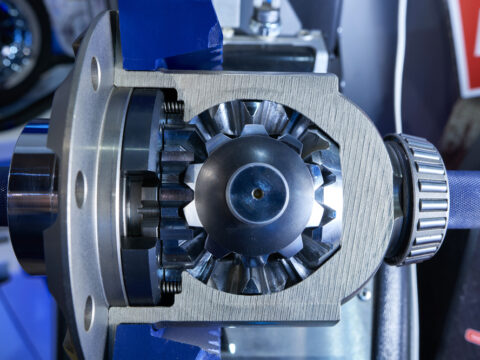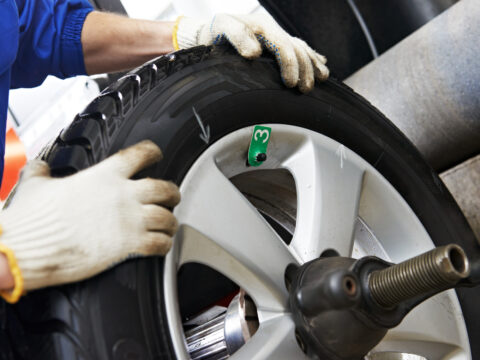All-wheel drive (AWD) and four-wheel-drive vehicles send power to all four wheels. A car that uses both front and rear wheels equally reduces the chance of skidding, slipping, or hydroplaning in wet conditions. However, this system consumes more energy than 2WD.

2WD vehicles use only the front two wheels for propulsion; this configuration offers better fuel economy because it reduces engine torque.
AWD and 4WD systems use the front and rear axles for power, improving handling in off-road conditions and increasing fuel consumption.
Contents
About All-Wheel-Drive Cars
AWD cars have an open differential in the center. If your front tires get a heavier load, such as when making a turn, the back tires rotate at a slower speed.
It’s called closed-differential when all wheels move at the same rate.
Mechanical AWD systems use the above-stated differential method. Electronic AWD drive systems use a variety of sensors to determine the vehicle’s grip on the road (traction) and send power accordingly to all four wheels.
All-wheel drive cars have several advantages over standard vehicles:
- They can handle better in slippery or snowy weather
- They’re less likely to spin out
- You can’t lose control if one wheel slips off the pavement
- Drivers can take corners faster because AWD cars generate more torque at low speeds
The Difference Between AWD vs. 4WD vs. 2WD
When shopping for a new car, it’s essential to understand the differences between 2WD, 4WD, and AWD, especially in performance and fuel efficiency.
Two-Wheel Drive (2WD)
A two-wheel drive is standard with today’s vehicles. In a setting like this, power only goes to the front or rear wheels, depending on what you pick, instead of all four wheels like in a four-wheel drive.
In most passenger cars, propulsion is on the front wheels (FWD) for improved traction up and down steep roads.
In most trucks and luxury cars, propulsion is on rear wheels (RWD) for enhanced traction when carrying heavy loads. Rear propulsion also equals better balance and handling.
Four-Wheel Drive (4WD)
The all-wheel-drive system uses two or more drive shafts to send power to each wheel. This system allows better performance in slippery conditions and increased fuel efficiency.
Four-wheel drive works similarly to AWD, but instead of using two drive shafts, it uses one on the front and one on the back axle.
The main difference between these systems is 4WD’s ability to transfer power from both axles simultaneously when needed; this gives it greater traction in difficult terrain than AWD alone can provide.
Does Driving in Awd Use More Gas?
Yes, all-wheel drive cars indeed use more gas. However, this depends on a lot of factors. The vehicle you drive, the type of transmission, and how often you use AWD all affect your gas mileage.
Automobiles with an all-wheel-drive system use about two more gallons per mile than a two-wheel drive car.
For example, the 2019 Mazda CX-5 automatic rear wheel format uses 6.9L/100km on average, and the same sized sedan with an AWD system uses 8.6Lm/100km in a comparison of fuel efficiency.
Does Turning Off AWD Save Gas?
Turning off AWD has been shown to reduce a car’s fuel consumption. Generally, making this change can be pretty simple and easy when it comes down to it for most off-road vehicles.
On some of these cars, all-wheel drive is mechanically disabled by an in-dash switch or lever that works as described.
To disable the AWD capabilities altogether, you must make hardware changes in some cars. However, you wouldn’t want to void any warranties by said modifications.
Does AWD Use More Gas Than 2WD?
First, an AWD car must expend extra power to accelerate at the same level as a 2WD car. Therefore an AWD car will have a more powerful engine with higher fuel demands.
It will also have to deal with more resistance from the road, requiring more horsepower to overcome this. There will be more friction and hence, the more gasoline it consumes.
Does AWD Use More Gas Than 4WD?
AWD and 4WD use the same amount of gas, and both use a transfer case to redirect the power to the wheels.
However, AWD may have a slight advantage regarding fuel efficiency. They can switch between the two-high (2H) mode for normal roads and the four-high (4H) mode for trickier terrains.

How Much More Gas Does AWD Use?
The answer to this question largely depends on the type of vehicle and its engine. On average, an AWD sport utility vehicle will use about 5% more fuel than its 2WD counterpart.
AWD uses a second set of wheels to aid with traction and control. It means that two separate drivetrains are working at any given time.
Why Does AWD Use More Gas?
The AWD system uses more gas because it needs more power to power all four wheels, but there is more to this than meets the eye.
Weight
There is the added weight of the AWD system itself. The AWD system has more components that weigh more than their 2WD counterparts. This extra weight requires more energy to move around, resulting in increased fuel consumption.
Gearing System
Another reason is that AWD vehicles have different gear ratios between each axle. Therefore they require more energy to spin each wheel when driving straight ahead or turning corners at low speeds.
Engine Size
The other reason why AWDs use more gas is that AWD vehicles tend to have larger engines than 2WD and 4WD vehicles.
A larger engine means more fuel consumption — even if the car weighs less than a similar model.
Road Surface
Finally, when driving on slippery surfaces like snow or ice, AWD’s all four wheels are engaged in driving the vehicle forward.
Navigating slippery terrain puts more stress on the engine and requires more fuel than driving with two wheels (like in a 2WD car).
Should You Drive in Awd All the Time?
It would be best if you used 4WD only when necessary because:
AWD vehicles are heavier than 2WD vehicles, so they might not perform as well as expected during acceleration or uphill climbs.
The extra weight also stresses suspension components and tires, leading to premature wear and tear on your vehicle’s parts.
AWD vehicles consume more fuel than their 2WD counterparts because they use more power when driving around corners or accelerating at high speeds – especially when climbing hills.
More Power Means More Gas
An AWD uses more gas because its design delivers a better performance which requires more power. An AWD or 4WD car model can perform better than a FWD or RWD model in handling and other areas.














